Biodiversity, the variety of life on Earth, is critical for maintaining ecosystem stability, resilience, and the overall wellness of the planet. Scientific study plays a pivotal position in understanding, conserving, and managing biodiversity. This article explores the multifaceted ways in which science contributes to the preservation of biodiversity, from ecological studies and genetic research to preservation strategies and policy development.
Ecological research forms often the backbone of biodiversity research, providing insights into the sophisticated interactions among species and their environments. Scientists conduct intensive field studies to file species diversity, population design, and habitat requirements. These studies are essential for identifying biodiversity hotspots, regions together with exceptionally high levels of species richness and endemism. As an example, research in tropical rainforests and coral reefs features revealed these areas since critical reservoirs of global biodiversity, necessitating targeted conservation attempts. Long-term ecological research projects, such as those undertaken by the National Ecological Observatory Network (NEON) in the United States, monitor changes in ecosystems over time, helping to track the particular impacts of climate adjust, habitat fragmentation, and other provocations to biodiversity.
Advances throughout genetic research have changed greatly our understanding of biodiversity in the molecular level. Techniques such as DNA barcoding and genomic sequencing allow scientists to identify and catalog species with unprecedented accuracy. These tools are particularly valuable for studying cryptic species, which are morphologically related but genetically distinct. By uncovering hidden diversity, anatomical research enhances our chance to assess and preserve the total spectrum of life on the planet. Additionally , genetic studies provide insights into the evolutionary procedures that generate and maintain biodiversity, informing conservation strategies directed at preserving genetic diversity along with adaptive potential within monde.
Conservation biology, an interdisciplinary science dedicated to the preservation of biodiversity, integrates environmental and genetic research along with social, economic, and community considerations. Conservation biologists develop and implement strategies to secure species and their habitats, carefully guided by principles of inhabitants viability, ecosystem health, and landscape connectivity. Protected places, such as national parks and also wildlife reserves, are proven based on scientific criteria to shield critical habitats and varieties. However , in situ conservation efforts are complemented by ex girlfriend or boyfriend situ measures, such as captive breeding programs and seeds banks, which serve as genetic repositories and last-resort actions for critically endangered types.
The field of restoration ecology focuses on rehabilitating degraded ecosystems to restore their biodiversity and also ecological functions. Restoration tasks, informed by scientific exploration, aim to re-establish native species, enhance habitat quality, and also reintroduce ecological processes for instance fire regimes and nutritional cycling. Successful restoration initiatives, like those in the Everglades in Florida and the Loess Plateau in China, display the potential for science-driven efforts to reverse biodiversity loss and restore ecosystem resilience. Recovery ecology also provides useful lessons for adaptive supervision, emphasizing the need for ongoing tracking, experimentation, and flexibility in resource efficiency practices.
Climate change techniques a significant threat to biodiversity, altering habitats, disrupting environmental interactions, and driving kinds to extinction. Scientific research is crucial for understanding the influences of climate change on biodiversity and developing adaptive strategies to mitigate these effects. Species distribution models, which predict shifts in kinds ranges in response to climate modify, help identify areas of foreseeable future habitat suitability and information conservation planning. Additionally , reports on climate resilience in addition to adaptation inform efforts to improve the capacity of species and ecosystems to withstand climatic adjustments. For example , research on coral reefs reef bleaching has led to the introduction of strategies to protect and recover reefs, such as selective multiplying for heat-tolerant coral traces and assisted migration to help cooler waters.
Science furthermore plays a critical role inside informing biodiversity policy as well as governance. International agreements, such as the Convention on Biological Range (CBD) click here to read and the Intergovernmental Science-Policy Platform on Biodiversity and also Ecosystem Services (IPBES), count on scientific assessments to set conservation targets, monitor progress, and also guide decision-making. National and native policies, including endangered varieties legislation and habitat safeguard regulations, are based on scientific proof species status and risks. Moreover, the integration of classic ecological knowledge with medical research enhances the effectiveness associated with biodiversity conservation, recognizing often the contributions of indigenous and native communities to sustainable learning resource management.
Citizen science projects engage the public in biodiversity research, expanding the attain and impact of technological efforts. Projects like the The holiday season Bird Count and the Global Biodiversity Information Facility (GBIF) involve volunteers in files collection, providing valuable home elevators species distribution, abundance, along with trends. Citizen science not only generates large-scale datasets but also fosters public awareness and support for biodiversity preservation. By involving people with scientific research, these pursuits bridge the gap involving science and society, selling a shared commitment for you to preserving the natural world.
Technological innovations usually are transforming biodiversity science, permitting more efficient and comprehensive files collection, analysis, and dissemination. Remote sensing technologies, for example satellite imagery and unmanned aerial vehicles (drones), provide high-resolution data on area cover, habitat changes, and species distributions. Bioacoustic monitoring uses automated recording equipment to detect and discover species based on their vocalizations, offering a noninvasive solution to tracking biodiversity in remote and challenging environments. Additionally , advances in artificial intellect and machine learning aid the analysis of large and also complex datasets, enhancing all of our ability to detect patterns, anticipate trends, and inform resource efficiency actions.
The preservation connected with biodiversity is a global very important that requires the integration of technological research with practical boucan efforts and policy frames. By advancing our comprehension of ecological processes, genetic selection, and the impacts of human being activities, science provides the foundation for effective biodiversity boucan. Collaborative efforts across exercises, sectors, and communities are very important to address the multifaceted obstacles of biodiversity loss and ensure the long-term sustainability of our own planet’s rich and diverse life forms.





